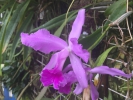|
|
|
|
|
| |
Flasks of
Cattleya lawrenceana 'MC1062' × self |
|
| |
|
|
| |
| Number: |
TN2357 |
| Name: |
Cattleya lawrenceana 'MC1062' × self
|
| Type: |
self (What's that?) |
|
Seed Donor: |
Dale Borders
|
|
Click to Enlarge

Pod Parent Flower |
Click to Enlarge

Offspring 'MC7565' Flower |
| Offspring photos are siblings of the plants you would receive. |
|
|
|
| |
Culture Notes from Donor: Parent plant: Temperature range I (60-83°F)
For additional origin/habitat information supplied courtesy of
Charles and Margaret Baker, see further below, near the bottom of this page.
|
Temperatures we attempt to use in the lab & greenhouse:
| For Species: |
|
Spring, Summer, Autumn, Winter: days average 87°F, nights 66°F; best fit is Warm-Intermediate 87-64°F
(Source:
Baker's Web OSC) |
| For Genus: |
|
Spring, Summer, Autumn, Winter: days average 83°F, nights 60°F; best fit is Intermediate 83-60°F
(
) |
|
About the name...
| Etymology of |
Cattleya |
|
Named in honor of William Cattley, English horticulturist in the 19th century.
(Source:
Pridgeon 1992) |
| Etymology of |
lawrenceana |
|
Named for Sir Trevor Lawrence, English orchid enthusiast, president of the Royal Horticultural Society in London in the 19th century.
(Source:
Mayr & Schmucker 1998) |
| Pronunciation of |
Cattleya |
|
KAT-lee-ya
(Sources:
Pridgeon 1992, Hawkes 1978) |
| Pronunciation of |
lawrenceana |
|
law-ren-see-AH-na
(Source:
Hawkes 1978) |
|
If you would like to direct someone to this web page, please copy and paste this URL into your email:
http://troymeyers.com/d?012357
| Flask Information |
| Availability: |
We have sold all of the flasks for this item. |
| You should: |
Consider getting individual plants or compots instead of a flask.
You can place a "Notify Flask Recipients" Request, and either we or a flask recipient may contact you when plants are available.
You may also place a "Notify Retries" Request, and if an identical pollination (the same parents) is done again, we'll let you know.
You may reserve a flask, but it's very unlikely you'll get one ...this could only happen if we found a flask that we didn't know we had. |
| Yield Estimate: |
240 plants (based on flask surveys done 04/04/2003 )
|
| Plantlet Sizes: |
From many flasks 2 - 40 mm plants (based on flask surveys done 04/04/2003 through 01/14/2004)
From one most recently surveyed flask 20 - 40 mm (01/14/2004)
|
|
You might also want to:
|
View the seed assay for this item.
View items of the same species.
View items of the same genus.
|
| Ordering Information |
| You are not currently logged in. |
|
You must be a registered user and be logged in to reserve a flask or place a notification request. Please log in:
|
|
|
|
|
|
| |
The origin/habitat information below is supplied courtesy of Charles and Margaret Baker
The following information is based on the name of the plant provided by the donor, and assumes that the name is correct. If the plant has been misidentified, then the following information may not be correct.
This text is copyrighted by the Bakers and may not be reproduced without permission.
ORIGIN/HABITAT: Venezuela. This species was originally reported to have
come from Guyana, but we have seen no recent reports of it occurring
there. In Venezuela, it is found in the central and southern highlands in
the States of Bolivar and Amazonas, especially in the vicinity of Mt.
Roraima, along the Río Carrao, and around Auyán-tepuí. Plants are usually
found at 1300–1950 ft. (400–600 m), but they are also reported as high as
3600–6050 ft. (1100–1850 m). Most recent collections have been from lower
elevations. Plants grow at the edge of forests, almost always near rivers
or streams.
Unconfirmed reports indicate that Cattleya lawrenceana also grows in
northern Brazil, but those reports may be the result of misidentification
and should actually refer to a different species.
More about this information and the Bakers...
|
|
|
| |
|
|
|